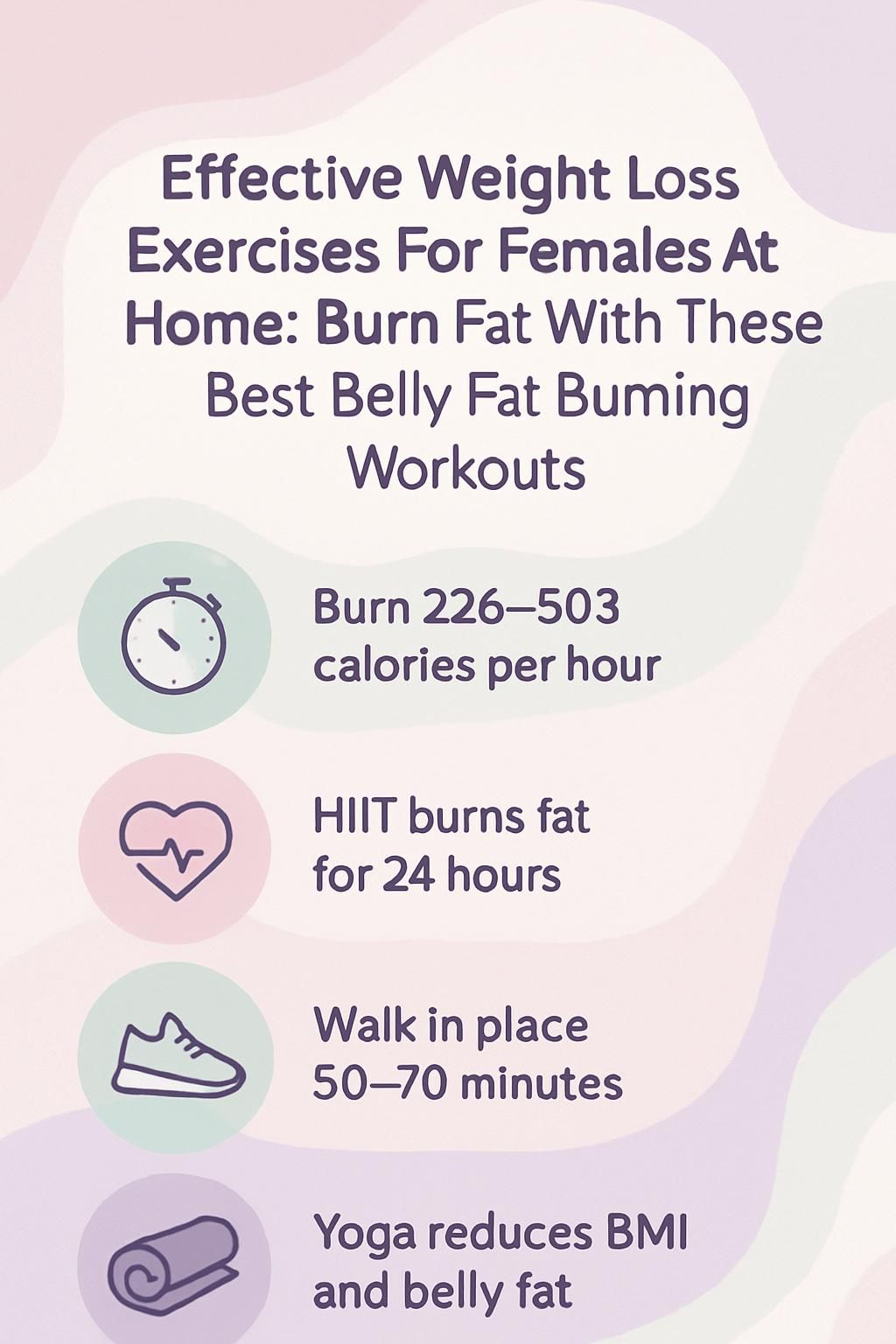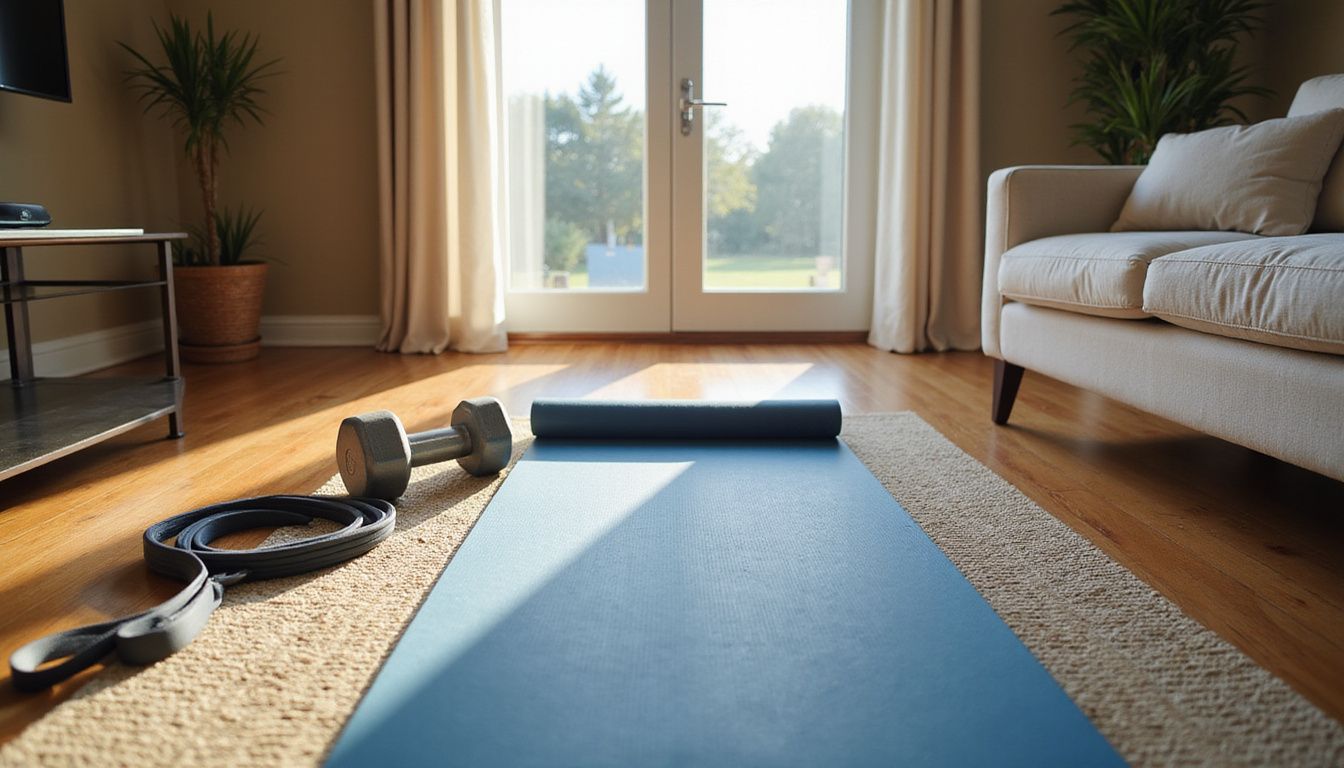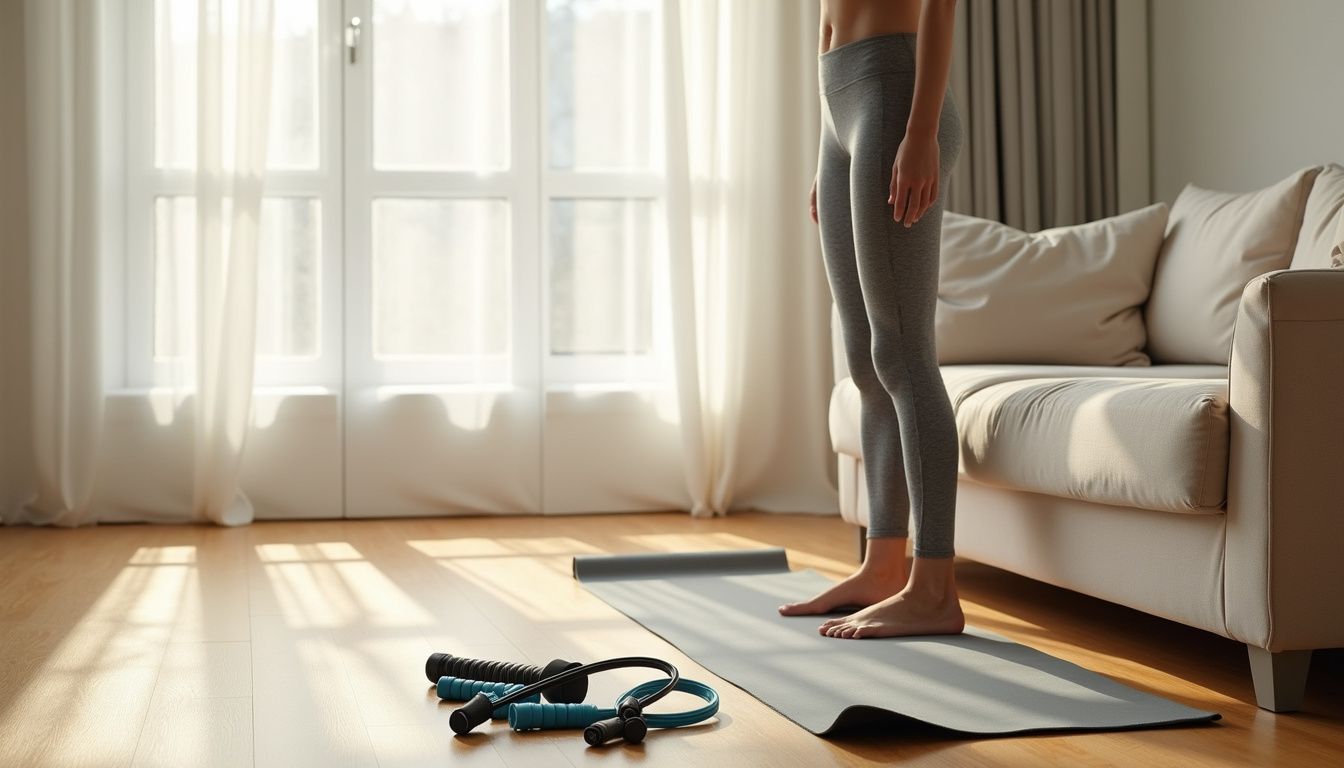Effective Weight Loss Exercises For Females At Home: Burn Fat With These Best Belly Fat Burning Workouts
Our Nutrition Assistant AI Suite will transform your body. You will lose fat, get toned, and build muscle. Gain confidence and optimal health.
If stubborn belly fat has been frustrating, you are not alone. Regular exercise is one of the strongest tools for weight management and lowering body fat.
This guide on Weight Loss Exercise For Female At Home walks you through easy and effective moves, such as squats, planks, lunges, and jump rope. Most sessions use your body weight or a few simple tools, so you can lose weight at home without a gym.
Set up a routine that keeps you motivated and increases fat burn week by week. Start today if you want steady change in how you look and feel.
Key Takeaways
- At-home workouts, including squats, planks, lunges, and skipping, can burn roughly 200 to 500 calories per hour with little or no equipment.
- High-Intensity Interval Training, called HIIT, often burns more calories than steady cardio and may boost fat burning for hours after you finish.
- Walking in place for 50 to 70 minutes, three times weekly, can modestly reduce body fat and waist size without leaving your home.
- Bodyweight resistance exercises such as squats, push-ups, planks, and lunges improve muscle tone and support weight loss at any fitness level (Lee & Kim, 2022).
- Yoga practiced once a week can lower BMI and reduce belly fat in women with abdominal obesity, based on Cramer et al., 2016.

Benefits of At-Home Workouts for Weight Loss

At-home workouts help you lose weight without a gym or commute. These exercises to lose fat are flexible, which makes it easier to keep physical fitness in your daily routine.
Why Are At-Home Workouts Convenient and Accessible?
You can perform exercises at home with almost no setup. Planks, push-ups, squats, lunges, and many aerobic routines use your body weight and need no special gear.
Walking in place or following workout videos on YouTube can add structure at zero cost. Most households have reliable internet access, which makes guided workouts easy to follow.*
Home sessions fit around your real life, such as before school runs or after work. Jump rope, indoor jogging, and simple calisthenics let you burn calories in small spaces.
“Home workouts let you focus on fitness goals without traveling or waiting for equipment.”
Many people prefer exercising at home because it supports consistency. This setting suits all fitness levels and can be adapted for conditions like diabetes under professional guidance.
…
*Pew Research Center: Internet/Broadband Fact Sheet (2021)
*Journal of Physical Activity & Health (2017): Exercise Adherence in Home-Based Settings
How Do At-Home Workouts Save Money?
At-home workouts help you avoid gym fees and class costs. Squats, planks, push-ups, and marching in place require no equipment and basic clothing.
Bodyweight strength training replaces many machines. A simple jump rope, often less than 10 dollars, offers strong calorie burn and cardio benefits.
No commuting means zero travel time and fuel costs. A small, dedicated corner in your living room can be enough to target multiple muscle groups and lose belly fat on a budget.
Privacy and comfort also support consistency, which is essential for long-term weight loss.
Why Choose Privacy and Comfort for Exercise?
Working out at home gives you privacy, which reduces self-consciousness and stress. You set the pace, choose your clothes, and adjust each move to your needs.
For many women, this comfortable setting improves commitment to a plan. It becomes easier to stick with squats, planks, or light cardio without fear of judgment.
I started my first cardio sessions in my living room because group settings made me nervous. Training at home helped me build confidence and stay consistent.
Next, see how to set up an effective workout space right in your home.
Preparing for Your Home Workouts
A comfortable space helps you show up, move safely, and make progress. The right clothing and simple tools, such as an exercise mat, support proper form and reduce injury risk during the best exercises to lose weight.
How Do You Set Up a Dedicated Workout Space?
A dedicated space keeps you organized and supports consistent results. A small clear area is enough for squats, lunges, and planks.
- Choose a spot free of clutter with at least one yoga mat’s length for movement and stretching.
- Ensure it is safe, with no loose items that could trip you during step jacks or squat jumps.
- Place an exercise mat for comfort during core moves such as crunches and planks.
- Check lighting and airflow to stay cool during intense workouts.
- Store optional tools nearby, such as bands or dumbbells, for biceps curls or triceps work.
- Wear breathable clothing and supportive shoes for HIIT, squats, or jump rope.
- Confirm you have space to complete 14 repetitions without bumping furniture or walls.
- Use a non-slip surface to protect your joints during balance drills.
- Return to the same spot daily to build a steady habit.
Next, learn which equipment is optional for home weight loss workouts.
What Equipment Is Optional for Home Workouts?
You can do most exercises to lose belly fat at home with body weight alone. Optional items can raise calorie burn, build muscle, and add comfort.
- Workout mats add support for planks, crunches, yoga, and stretches, which reduces stress on knees and forearms.
- Jump ropes are powerful aerobic tools. Skipping may burn 226 to 503 calories per hour depending on speed and body size.
- Light dumbbells or resistance bands increase challenge for squats, lunges, curls, and shoulder raises.
- Pull-up bars train several upper body muscles such as back, arms, and chest. Start with small sets and add reps over time.
- Comfortable shoes protect your feet during high-impact moves like jogging in place or jacks.
- Filled water bottles can work as light weights for squats or arm curls.
- Towels help with grip and sweat control during longer sessions.
After setting up optional equipment for home workouts, you can focus on choosing clothing that keeps you comfortable and mobile.
What Clothing Is Best for Comfortable Workouts?
Choose breathable, moisture-wicking fabrics to pull sweat off your skin. Wear a supportive sports bra for high-impact moves such as jump rope or burpees.
Flexible clothing works best for squats, lunges, yoga, and any move that uses multiple muscles. Shoes with good cushioning help with jogging in place and lateral steps.
Make sure your outfit allows a full range of motion for stretching and balance. Dress for the room temperature to avoid overheating or chills. My go-to gear is a quick-dry tank, stretchy leggings, and running shoes with arch support.
Setting up your workout area comes next so you can move confidently through each exercise.
Best Weight Loss Exercises for Females at Home
Use focused workouts that train several muscles at once, raise your heart rate, and support a healthy body composition. These are some of the best exercises to lose weight at home.
What Are Effective Aerobic Exercises at Home?
Aerobic exercise increases heart rate, boosts metabolism, and builds endurance. Many routines need little space.
- Walking in place is low impact and burns steady calories. Doing it 50 to 70 minutes, three times a week, can reduce body fat and waist size.
- Jogging at home at 6 to 9 km per hour may burn about 298 calories in 30 minutes. It supports weight control and trims abdominal fat.
- Running, even in short indoor bursts or on a treadmill, can burn about 372 calories per half hour at 10 kilometers per hour.
- Skipping rope often burns 226 to 503 calories per hour, training the core and legs at the same time.
- Step jacks and step-back jacks are joint friendly and help build cardio endurance.
- Aerobic dance videos on YouTube offer guided moves that keep workouts fun and structured.
- High knees lift heart rate quickly and fire up the core.
I lost about five pounds over six months with jogging in place, jump rope, and step jacks. Tracking at home kept things simple and consistent.
Read on to see how skipping or jumping rope can accelerate fat loss.
How Does Skipping or Jumping Rope Help Burn Fat?
Jump rope delivers a fast, high-calorie workout using very little space. Thirty minutes often burns more calories than a casual walk on a treadmill.
Depending on speed and body size, a session can burn roughly 226 to 503 calories per hour. The constant rhythm raises heart rate and trains legs, core, shoulders, and arms together.
Skipping supports reductions in visceral fat, the deep belly fat linked to health risks. It improves coordination, tones muscles, and often boosts mood due to endorphins released during exercise. A basic rope is all you need to get results.
What Is High-Intensity Interval Training (HIIT)?
HIIT uses brief bursts of hard effort mixed with easy work or rest. For example, do burpees, squat jumps, or mountain climbers for 30 seconds, then recover for 30 seconds.
This style often burns more calories than steady cardio and can raise post-workout fat burning for up to a day. Some studies also report lower cortisol, the stress hormone linked to belly fat.
Try a one-hour interval pattern, such as 15 minutes walking, 15 minutes jogging, 15 minutes running, 10 minutes jogging, then a five-minute walk. Bodyweight strength pairs well with HIIT to build core strength and muscle tone.
How to Use Bodyweight Resistance Training?
After trying HIIT, add bodyweight strength to build muscle and support fat loss. No equipment is needed to start.
- Begin with squats to train your lower body. Aim for 12 to 15 repetitions for 3 to 4 sets.
- Perform lunges on each leg to target glutes and thighs. Repeat 12 to 15 times per side with solid form.
- Add push-ups for chest, shoulders, triceps, and core. Try at least two weekly sessions.
- Hold planks or reverse planks for 30 to 60 seconds. Complete 2 to 3 sets.
- Practice pull-ups if you have a safe bar. Do small sets and build up slowly.
- Use bicycle crunches to work your entire core. Move with control, not speed.
- Rotate exercises with short rest periods if you are conditioned and want a higher calorie burn.
- Use this approach two days per week along with cardio such as marching drills and jump rope.
This simple plan helps you build muscle and support health conditions such as polycystic ovary syndrome while training at home.
Top Belly Fat Burning Workouts
Many effective belly fat burning workouts use simple moves you can do in your living room. They train the core, improve awareness of body position, and support overall health.
How Do Planks and Their Variations Burn Belly Fat?
Planks target your core and improve stability. They support a higher metabolism, although no single move can melt belly fat on its own.
- Planks train your abs, shoulders, back, chest, and hips at the same time.
- A standard straight-arm plank is beginner friendly and improves posture.
- Recent research suggests regular planks can improve breathing capacity along with core strength.
- Mountain climbers, a moving plank variation, raise heart rate and support calorie burn.
- Reverse planks strengthen the backside of your body. Hold for 30 to 60 seconds for 2 to 3 sets.
- While planks are not a high-calorie move, they build muscle and support weight loss when combined with cardio.
- All variations are easy to do at home with minimal equipment.
Explore bicycle crunches next for strong core activation.
Why Are Bicycle Crunches Effective for the Core?
Bicycle crunches train your upper abs, lower abs, and obliques at the same time. The twist adds extra work for the waistline muscles.
They often activate more abdominal fibers than many other core moves. Since you use body weight for resistance, no special gear is required.
Short, intense sets of 30 seconds can raise heart rate and increase calorie burn while building strength. I added bicycle crunches to my morning routine and felt a stronger core within a few weeks.
How to Perform Standing Mountain Climbers Correctly?
Standing mountain climbers offer a full-body, fat-burning move with no floor work. The motion is quick, so focus on form first.
- Stand with feet hip-width apart and arms by your sides.
- Reach both arms overhead to start. Keep your back straight and shoulders relaxed.
- Drive one knee toward your chest while pulling the opposite arm down.
- Alternate sides with quick, controlled reps for 20 to 25 repetitions.
- Brace your core to support your lower back.
- Point knees forward. Avoid twisting your hips or shoulders.
- Keep a brisk, safe pace to raise heart rate and limit injury risk.
- Exhale as the knee drives up. Inhale as you reset.
- Use them in HIIT or circuits for strong calorie burn without equipment.
Ready to progress? The next moves target new muscles while staying simple.
What Is the Side Lunge with Diagonal Reach?
The side lunge with diagonal reach trains quads, glutes, hamstrings, and core. It also builds balance and endurance while raising calorie burn.
- Perform 14 repetitions on each leg, then repeat for 28 total reps.
- Keep one knee bent and the other leg straight to engage large muscle groups.
- Reach diagonally across your body as you lunge to recruit the obliques.
- Complete 30 alternating reps for fuller activation.
- Add light weights or household items to increase challenge.
- Point both feet forward to protect your knees and hips.
- Move with control instead of rushing to keep form sharp.
Next, try the rotational squat plus low jack to advance core and cardio in one set.
How to Do the Rotational Squat + Low Jack?
This combination targets your legs, core, and cardiovascular system. It blends strength with steady calorie burn.
- Stand tall with feet shoulder-width apart.
- Lower into a squat, twist your torso to the right, and reach toward the outside of your knee.
- Return to center and stand up.
- Squat again, twist left, and reach toward the opposite knee.
- Perform 14 alternating reps to train both sides.
- Move into low jacks. Stay in a half squat, then step one foot out at a time.
- Complete 14 slow star jumps or low jacks. Prioritize form over speed.
- Keep your core braced to improve balance and calorie burn.
- Wear grippy shoes if you train on hard floors. Stop if you feel pain or dizziness, and talk to your doctor if you have medical concerns.
Combining rotational squats with low jacks always spikes my heart rate without any equipment.
Full-Body Workouts to Boost Fat Burn
Full-body sessions recruit large muscles and elevate heart rate. That combination helps you burn more calories and lose weight faster.
How Do Burpees Help in Fat Burning?
Burpees blend strength and cardio in one move. They train the chest, legs, arms, and core every repetition.
Even a single set of 14 reps can raise calorie burn quickly. No equipment is needed, which makes burpees ideal for HIIT at home.
After adding burpees to my routine from YouTube workouts, I noticed better endurance and improved energy within two weeks.
What Are the Benefits of Push-Ups?
Push-ups train your chest, triceps, shoulders, and core. You need only a flat surface and some space.
Place hands slightly wider than shoulder-width, keep your body straight, and aim for 3 sets of 10 to 15 reps. Research suggests push-ups offer a modest metabolic boost and fit easily into home plans.
You gain strength, save time, and build fitness using just body weight.
How to Effectively Do Squats and Squat Jumps?
After building upper body strength, focus on lower body. Squats and squat jumps train large muscles and support fat loss.
- Stand with feet slightly wider than hips, toes forward. Keep chest lifted and back straight.
- Bend knees and ankles, sending hips back as if sitting in a chair.
- Push through your heels to stand. Squeeze your glutes at the top.
- Perform 14 repetitions per set to build endurance and strength.
- Beginners can do 3 sets of 12 to 15 squats while learning good form.
- To increase intensity, add squat jumps. Leave the floor briefly, then land softly.
- Recent studies show bodyweight squats support lower body strength gains in young women.
- Wear clothing that allows free movement and shoes with good grip.
- Train on a stable surface with enough space for safe landings.
- Squat jumps raised my heart rate fast and strengthened my legs within two weeks.
Squats improve strength, mobility, and balance while supporting fat loss in a simple home routine.
Why Include Lunges and Jumping Lunges?
Lunges and jumping lunges are powerful for fat burn and leg strength. They also challenge balance and coordination.
- Lunges work quads, glutes, hamstrings, and core in every rep.
- Thirty alternating lunges help build lean muscle. Light weights can increase the challenge.
- Step into a deep lunge with the front thigh parallel to the floor, then switch sides.
- Jumping lunges add a power element that raises heart rate and calorie burn.
- Research shows lunge exercises improve muscle function and balance (Lee & Kim, 2022).
- Try 14 jumping lunges for a quick, equipment-free finisher.
- Use lunges in core or full-body circuits to strengthen your legs and midsection together.
Read on to see how other full-body moves can lift calorie burn with simple steps.
How Do High Knees Increase Fat Burn?
After training with lunges, high knees provide an intense cardio burst. The quick pace raises heart rate and pushes your body to burn more calories in less time.
Use high knees in HIIT or aerobic circuits for a strong effect. Aim for 14 repetitions in a circuit, then repeat as your fitness improves.
This move also improves coordination and strengthens the core and lower body without extra space or tools.
Low-Impact Exercises for Beginners
Low-impact exercises protect your joints while you build a routine. These beginner-friendly choices support steady fat loss and confidence.
How to Walk in Place for Weight Loss?
Walking in place is an easy way to burn calories and lift energy. It fits any fitness level and needs no equipment.
- Choose a flat, non-slip area and clear obstacles.
- Wear comfortable clothing and supportive shoes.
- Set a 30-minute timer for a brisk indoor walk, about 150 extra calories.
- Start slow. Lift knees gently and swing arms to raise heart rate.
- Increase pace every five minutes or lift knees higher.
- Walk in place 50 to 70 minutes, three times weekly, to reduce body fat and waist size.
- Track progress with a watch or phone app.
- If tired, slow the pace but keep moving.
- Add five minutes as it gets easier.
- Indoor walking offers privacy and works during bad weather.
- I used music to stay motivated and felt better energy after one week.
Walking in place remains one of the most accessible aerobic exercises. It fits easily into daily life at home.
What Are the Benefits of Yoga for Core Strength?
Yoga builds core strength with poses like Plank, Bridge, Warrior, and Bow. These target your abs, back, and hips while improving balance.
Practicing once a week can help lower BMI and improve mindful eating. A 30-minute session may burn about 120 to 168 calories based on intensity. Cramer et al., 2016, reported reduced belly fat in women with abdominal obesity.
I added Sun Salutation and Shoulder pose last year. My posture and midsection strength improved in daily tasks.
How Does Pilates Help Tone the Body?
Pilates targets the core with slow, controlled movements that also strengthen the whole body. You can adjust intensity for any level and still improve posture and muscle tone.
Health sources report that Pilates improves flexibility and trains major muscle groups through precise control. You only need a mat or towel to get started at home.
Pilates is a safe, low-impact path to strength, which helps prevent injury while you progress.
Tips to Maximize Weight Loss Results
These practical tips will help you get more from your home routine.
How to Maintain Proper Form to Avoid Injury?
Keep your body aligned in every exercise. In squats and lunges, track knees over toes, keep your back neutral, and brace your core.
Use a mirror or record your sets to check posture. Move slowly at first and master technique before adding speed or weight. In push-ups and planks, place wrists under shoulders to reduce joint stress.
Controlled movements beat rushed reps for both safety and results. In my own training, watching foot position during squats cut my knee discomfort. The American Council on Exercise reports that better technique can raise workout effectiveness by roughly 30 percent.
Why Is a Consistent Workout Routine Important?
Good form prevents injuries, but consistency drives progress. A regular schedule builds habit and keeps motivation steady.
Guidance from the American College of Sports Medicine suggests training 2 to 3 times per week for lasting fat loss and strength. Practicing each belly fat burning move for a planned number of reps also supports steady gains.
Scheduling sessions at the same time kept my routine on track during busy weeks. Consistency turns workouts into a natural part of your day.
How to Combine Workouts with a Balanced Diet?
Pair your workouts with a balanced diet for sustainable results. Estimate your daily calories using your ideal body weight in pounds, then multiply by 14.
For example, an ideal weight of 130 pounds equals about 1,820 calories per day. Eat regular meals. Skipping meals can lower metabolism and slow fat loss.
Choose lean protein, vegetables, whole grains, and healthy fats in smart portions. This balance fuels training, supports recovery, and helps control hunger.
Why Stay Hydrated and Get Enough Sleep?
Water supports metabolism, energy, and recovery. Even mild dehydration can reduce performance and slow fat burning.
Quality sleep helps regulate hormones that control hunger and stress. Poor sleep raises cortisol, which may promote belly fat and muscle loss. Aim for seven to nine hours per night.
Hydration and sleep amplify the results of your belly fat burning workouts at home.
Frequently Asked Questions
You may still have questions about home workouts and weight loss routines. Here are clear answers to help you plan your week.
How Many Times a Week Should I Exercise?
Exercise at least 2 to 3 times a week for weight loss. Mix aerobic exercise and resistance training to burn fat and build muscle.
Include strength work, such as squats or push-ups, at least twice weekly. Many health groups recommend about 300 minutes of moderate activity per week for effective weight loss.
Splitting workouts across several days reduces fatigue and improves consistency.
Can I Lose Weight Without Equipment?
Yes. Bodyweight exercises such as planks, squats, lunges, and push-ups burn calories and build muscle. Walking or jogging in place also works without tools.
Jump rope only needs a basic rope if you choose to use one. Yoga and Pilates require just a mat for comfort. Pull-ups need a sturdy bar, but no other gear. Studies from the American Council on Exercise show people can reduce fat with consistent bodyweight routines alone.
These methods make weight loss possible even without gym machines.
…
[1] Source: American Council on Exercise, “Benefits of No-Equipment Home Workouts,” 2020
What Is the Best Time of Day to Exercise?
Timing may affect how a workout feels, but there is no single best time. Morning sessions can fit well with daily routines, and some prefer to train before the day gets busy.
Evening sessions may feel easier because body temperature and oxygen use are higher. Most experts agree that consistency matters most. Choose a time you can repeat most days.
Conclusion
Effective weight loss exercises for females at home can help you burn belly fat and improve health. You do not need fancy equipment or a gym membership to begin. Pick a mix of aerobic exercise, simple strength moves, and core work that fits your schedule.
Focus on form and set weekly times to train. Pair workouts with a balanced diet, good sleep, and basic stress control for the best results. If you have medical conditions or pain, consult a healthcare professional before starting a new plan.
Stay consistent, track small wins, and keep going. Each workout is a step toward a stronger body and a healthier life.
FAQs
1. What are the most effective weight loss exercises for females at home to burn belly fat?
Research shows that aerobic activities such as brisk walking, cycling, and high-intensity interval training help reduce abdominal fat in women. Bodyweight movements like squats, lunges, and planks also target core muscles and support overall fat loss. A 2022 study published in Obesity Reviews found that combining cardio with resistance routines leads to greater reductions in waist circumference compared to either method alone.
2. How often should females perform these workouts for best results?
Experts recommend engaging in moderate-intensity exercise at least five days per week for thirty minutes each session. For optimal belly fat reduction, include both cardiovascular and strength-based movements on alternating days. According to the Centers for Disease Control and Prevention (CDC), consistent physical activity improves long-term weight management outcomes.
3. Can diet changes enhance the effects of home workouts on belly fat loss?
Yes; pairing regular exercise with a balanced eating plan increases success rates for losing abdominal fat. Studies indicate that reducing added sugars while increasing fiber intake helps decrease visceral adiposity more effectively than exercise or diet alone (Harvard T.H. Chan School of Public Health). Tracking daily calorie consumption can further support progress toward body composition goals.
4. Are there any personal experiences supporting these workout methods?
Many women report positive results after following structured routines focused on both movement variety and nutritional balance at home settings. One participant shared her experience: “After three months of mixing interval sessions with core-focused circuits and mindful eating habits, I noticed visible changes around my midsection.” This aligns with clinical findings showing combined approaches yield measurable improvements over time.
Summary: Aerobic activities paired with strength training form an evidence-backed strategy for burning belly fat among women exercising at home; integrating dietary adjustments enhances effectiveness; consistency is key according to health authorities; real-life accounts confirm benefits observed in scientific studies.







